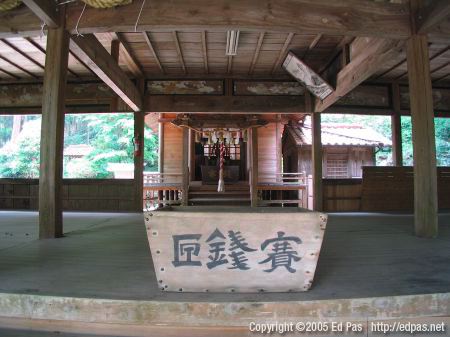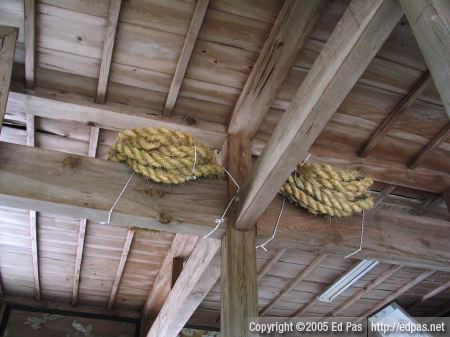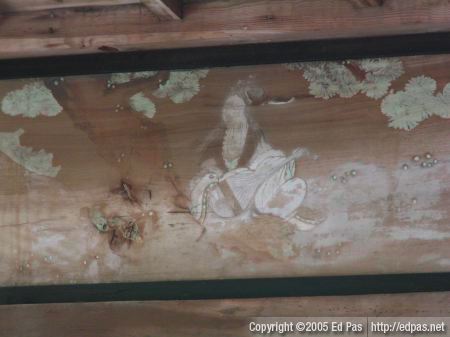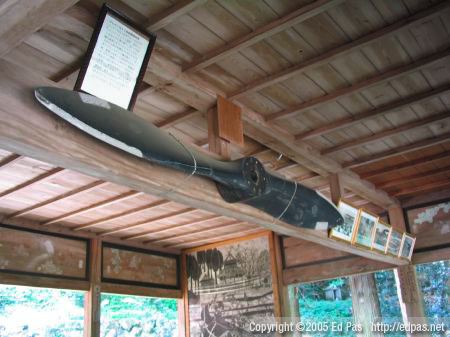Today you get to read the second part of my feature on Nishi Ono Hachiman Shrine in Kokura-minami. You can expect some standard interior views of a traditional Shinto shrine, as well as an aviation surprise at the end.
The end of the saga of my April 30th bike trip is near. Another few posts and it’ll be back to strange product labels, girls in short skirts, and other assorted brain kipple. Here’s where you can find the older posts in this series: Introduction, Part 1: Snakes, Part 2: Not A Temple, Part 3: Frogs, Part 4: Farming Grannies, Part 5: Reservoir Mobs, Part 6: Dammed Rivers, Part 7: Sevenfold Waterfalls Post 1, and Post 2, and Part 8: Nishi Ono Hachiman Shrine Post 1.
Here’s a look into the main shrine building complex, from the top of the front steps looking through the centre of the buildings. This seems to be a standard layout, with all of the buildings lined up. There’s usually a reception-type building which people can enter, followed by a smaller enclosure that usually contains some sacred objects. And then there’s a rear building that’s often completely sealed. Sometimes the first two buildings are combined into one. Sugawara Jinja in Tobata, Kitakyushu is like this, having a main shrine consisting of only two connected buildings.

Here another view from the same perspective, this time shot with a wide angle lens. It shows a bit more of the context. The curves you see are distortion caused by the lens. In my reality all of the lines are actually straight. The box in front is for donations. Note the whitish pictures above the beams at the back of the building and the edges of some ropes in the upper left corner of the picture. I’ll be talking about them next.

This is a detail view into the “ceiling” of the first building. I’m continually amazed by the wooden buildings here—the joinery is incredibly precise—traditional-style houses are still often built with similar methods. In the centre of the photo are the ropes I pointed out in the previous picture. They’re the same kind of rope as used to mark sacred places—I still haven’t looked for the name—but I’m not sure why they’re coiled here. It might simply be for storage or there might be some deeper spiritual purpose. The beams run through the middle of the building left-to-right across its width. The pillar in this shot is left of the centre.

Next are three details of the paintings above the beams at the back of the building. These paintings are on the the actual building, as opposed to having been hung as separate objects. The first image is from the far left edge of the wide-angle shot above. There’s a woman with what looks like a biwa—a Japanese lute—and there are flowers around her. I’m not going to pretend to know what kind of flowers they are, what the faded things on the ground are, or what the symbolism of the piece is. If anyone has any ideas, I’ll be happy to have the veil of ignorance lifted by your knowledge.

To the right of that painting is one with a couple of birds on a rock. Hung in front of it are what appear to be donation plaques. I can’t read most of the characters, but some of them represent numbers followed by what appears to be a family name. For example, the fourth one from the right has, from top to bottom, three characters I can’t read, then three characters that mean 100,000 yen, then the family name Uemura—it translates literally as “above the village”—and then what appears to be a male first name.

I’m going to skip the two panels that are over the centre of the building since I didn’t take pictures of them. This next one is immediately to the right of the centre section. It’s a mask of a guy with a really long nose. From what I recall, he’s a famous god-spirit or demon but I can’t remember which. There’s some symbology that involves him, fertility, penises and such, and there’s a festival dedicated to him that’s held in many communities. Although I’ve never been to one of the festivals in his honour, I’ve seen a couple of videos. No, not that kind of videos but I wouldn’t be surprised if they exist. They were part of a cultural information kiosk at the Miyazaki Museum of Natural History. A priest dresses up in full costume including the wooden mask, and chases after everyone. The simpler explanation of course, is that it’s a painting of one of many styles of Noh theatre masks.

Attached the centre beam on the right side of the building we have a surprise! It’s an airplane propeller complete with an informative plaque—all in Japanese—and an assortment of photos. My initial reaction was a slightly more colourful expression meaning something along the lines of an emphatic “huh?”

A detail of the plaque follows for those of you who want to try your hand a deciphering the Japanese. After reading it, of the teachers at my school—she was also perplexed by it—gave me an overview. If you habitually fall asleep when presented with aviation trivia, you can skip the next paragraph and photo. And the rest of this post, for that matter. Actually, scratch that. It’s interesting enough to continue reading.
The propeller is from a Breguet 19 A2 airplane which saw civilian service in Japan in the 1920s. At one point, this type of plane set a long-distance flying record. During World War Two the plane was confiscated by the military but it was not used in Japan’s failed attempt at world military conquest the war effort. There’s also something to do with France in the text.

I had too many unanswered questions about the plane so I got a more detailed translation and did a bit of research online. The Breguet 19, an all-purpose airplane designed and built in France, went through a number of incarnations and broke a number of distance flying records in the 1920s. Some versions were used as bombers as late as the Spanish Civil War, but the plane was most famous for its ability to fly long distances. Asahi Shimbun Corporation—one of Japan’s major newspapers—imported two Breguet 19 A2 planes for testing. Testing what? I’m not sure. The text says that the planes were used for “communication,” which could mean anything from dispatching reporters and/or their stories, mail duties, distribution of newspapers, propaganda, to aerial surveillance and other top secret spy stuff. The imports to Japan were the reconnaissance model of what was often used as bomber in Europe.
The planes brought to Japan made several trips to Europe in the twenties. Only two of these planes were ever imported to Japan during their production life. At some point their identification names were changed to “J-KIRI” and “J-BAFA” but I don’t know what the original IDs were or if they even had any. I also don’t know why a newspaper was so interested in aviation—perhaps it was caught up in the excitement of something newsworthy—at one point in the late 1920s or early 1930s the Asahi Shimbun sponsored a US$25,000 contest for the first to fly nonstop from Japan to America. I don’t know who won, or what model of plane was used, but translated into today’s currency, that’s probably the era’s equivalent of the X Prize. So much ignorance! So many questions.
What happened to the planes after their useable life was over? One was stored at a science museum—the text doesn’t specify which museum, where it is, or whether the plane is still intact—and the military got hold of the other one. The one from the military was eventually disposed of and its propeller found its way here.
For further reading, Google’s cache has a history of the Breguet 19. Be warned that the page is ugly and the original page gives an error. There’s also a history of the Breguet 19, with pictures, but it’s all in Japanese and the online translators don’t handle it very easily. And here’s a page of schematics and engine photos. You can also search google for the term Breguet XIX if you want more detail.
I have a few more interior photos from the shrine, but this post is already much longer than I’d planned, so I’ll continue tomorrow.
[The next post in this series is Rural Kitakyushu: Nishi Ono Hachiman Shrine, Part 3]
ah yes, kipple
from one of the great works
of speculative fiction
a similar term i use often is “drek”
i think i read it first
in the Retief series by Keith Laumer
(my googling reveals drek (dreck) is yiddish
for “dung” or “trash”)